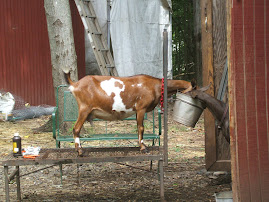Every time I make cheese, I also make whey and hate to waste it. I like the idea that one gallon of milk can produce two different products. Whey is ready for consumption and was commonly enjoyed in coffeehouses and inns in the 18th century. You can add some lemon and sugar to make whey lemonade. Today whey is often sold as a nutritional supplement in the form of a dried powder.
Whey can also be called milk plasma which sounds a little gross. Whey contains proteins, vitamins, minerals, lactose, and a trace amount of fat. Studies have shown that whey can stimulate insulin production and can assist in regulating and reducing spikes in blood sugar. The protein in whey is more easily absorbed then the proteins in egg whites which is apart of the body building appeal. Whey can also prevent the atrophy of muscular cells which is another attraction.
After making the Feta, I decided to experiment with the whey. Whey can be made into cream, butter, Ricotta, Brunost, Gjetost, and Mytost. These last 3 cheeses are very similar and names can vary by regions. Brunost is Norwegian for brown cheese and Gjetost and Mytost are types of brown cheese. Gjetost is a goat’s milk version and Mytost is made from cow’s milk. I found a recipe for Mytost that included substitutions to make Gjetost. Gjetost is pronounce like "yay toast" which I think is a very fun cheese name!
One issue with making cheese from whey is the short window of time. The whey cannot be more that 4 hours old for the production of Ricotta or Brunost. I had finished making my Feta around 6 p.m. and began to boil down the whey. The recipe said that foam would rise to the top and to skim it off and reserve it for later but this did not occur in my pot. Adding the foam back was supposed to help thicken the whey. Once the whey starts to thicken, I poured it into a blender and blended for about a minute. This is supposed to make a smoother cheese but it also made it foam and thicken.
The recipe also had an option to add cream to the mix but seeing as I didn’t have any I left that step out. Boiling down the whey can take 6-12 hours and by 11 p.m. I was a very sleepy girl who did not want to leave the whey unattended on the stove. The whey had drastically decreased in volume so I hoped I was getting close to cheese. At first the whey was a thin liquid with a cream colored tinge, as the whey boiled down and I stirred the liquid, I could feel it thickening.
I spent an hour stirring my hot pot with the intention to give up at midnight. At about 11:45 p.m., the whey began to turn into the consistency of caramel sauce. Time will produce more caramelization and the color would become a deeper shade of brown and the flavors more concentrated. At midnight, I placed my pot in a cold bath and stirred some more until the thick cheese sauce had cooled. I then poured it into a buttered tupperwear and put it into the fridge where it will keep for up to four weeks.
As my time management skills were lacking, my cheese was a tan color. I know step by step photos of this process would be nice but I did not take any, sorry. But here is the finished product.


My Gjetost was softer and creamier then store bought versions which tend to be semi-firm. The texture of my Gjetost was similar to fudge but it did have some sandy grains despite the blending but maybe I should have blended it longer. I think it tasted just like the innards of a Lance’s sour cream & chive wheat cracker but without the chive. It was sweet and tangy with notes of caramel and salt. Next time, I will start my cheesemaking process earlier and let my whey go longer.
























No comments:
Post a Comment